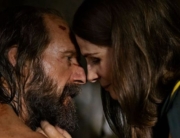Her father died on the Titanic. She bought art directly from Picasso, Giacometti, Brancusi, and de Kooning, and drank with them, too. Her failed sexual encounter with Jackson Pollock ended when he “threw his drawers out the window.” And she lived out her last years in a magnificent palazzo in Venice, leaving behind a socko art collection that draws viewers from all over the world. Peggy Guggenheim had quite a life, but that’s not all. In its discreet, conventional way, Peggy Guggenheim: Art Addict aims to establish this influential collector as a major figure in 20th-century art. The film mostly succeeds, and Guggenheim’s personal recollections keep it fresh.
Peggy Guggenheim arises from a trove of interview tapes recently rediscovered by Guggenheim biographer Jacqueline B. Weld. They form a spoken-word armature on which to base the film. Ladylike and matter-of-fact, Guggenheim’s voice flattens memories of terrible grief and sexual dish into it-is-what-it-is offhandedness. Conventional use of stock footage and a rather stodgy period score add up to a subdued affair at the production level. Luckily, though, good stories and the sheer volume of artistic genius on display propel the film forward at a dignified pace.
Guggenheim grew up feeling like a poor relation in a fabulously wealthy and quarrelsome New York Jewish family. She struck out on her own early and headed for Paris in the 1920s, where eager esthetes and wannabes flocked to the endlessly dynamic art scene. Mentor Marcel Duchamp taught her how to look at paintings and encouraged her to buy works by up-and-comers Paul Klee, Salvador Dalí, Joan Miró, and Georges Braque. She sponsored artists, some for all their lives, and founded a gallery that helped shift the center of the art world to 1950s New York. A true love of art and unbeatable connections put Guggenheim ahead of the curve.
Not everyone approved. Unabashed promiscuity made possible by money (as Gore Vidal pointed out, the rich get laid more often than you and me), booze, and an odd appearance resulting from a botched nose job made Guggenheim something of a laughingstock, especially in her later years, and doubts have always hung over her real understanding of and commitment to the art she championed.
Well, Guggenheim was one tough cookie. During the Nazi occupation, she took great personal risks to go to Paris and buy up threatened art. When the Louvre refused her request to store the works, she got them out of the country herself, enjoying the last laugh with a Louvre exhibit of her collection after the war. Guggenheim generously transported artists to safety; they would have ended up in concentration camps without her protection.
As well as a tough cookie, she was also a shrewd one, with a sharp eye for talent. One of the film’s strengths lies in its showing off the miles and miles of great pieces that Guggenheim amassed. She discovered Jackson Pollock (driven and scary in the film’s clips of him at work) and gave him space to create. Rich but not superrich, she drove hard bargains and usually got what she set her eye on, and her art collection made Venice a major modern art attraction.
Sadness runs through Guggenheim’s chatty memories, with ill-fated marriages, unexpected deaths, and a suicide casting a shadow over the sexual adventures and artistic coups. Filmmaker Lisa Immordino Vreeland has enlisted mostly male art historians and commentators to share their impressions of Guggenheim and her legacy. While knowledgeable and cultured—oh, those plummy voices—many seem weirdly condescending and unsympathetic to the woman. It’s a good thing for the film that her plainspoken recollections drown them out. If she were alive today, let’s hope Guggenheim would ignore her critics. She’d carry on with the mixture of eccentricity, abandon, and fatalism that marked her life—and hopefully spot some great paintings.
















Leave A Comment